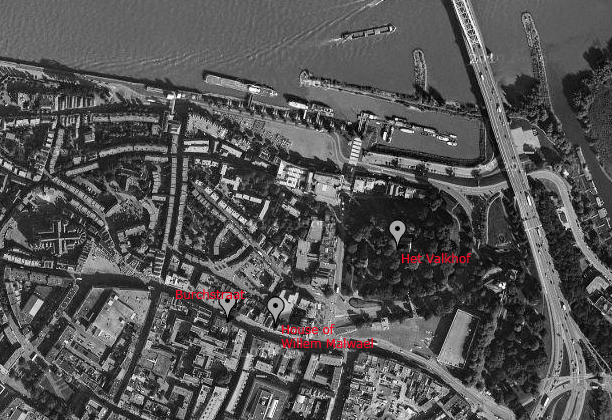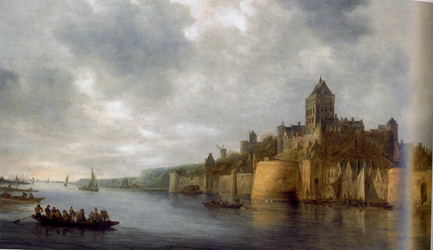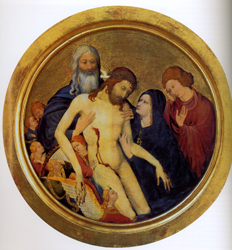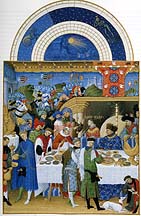Art Home | ARTH Courses | ARTH 214 Assignments | Très riches Heures Seminar | ARTH 294 Assignments
The Limbourg Brothers
Considering that artists were still generally anonymous, we know remarkably a lot about the artists we know as the Limbourg brothers. While in a number of respects their biographies are fairly typical of artists of the period, the documents make it clear that they were clearly exceptional artists. Before considering their actual work, it is worth while to review the documentation associated with their relatively short but very productive careers.
Although they made their reputations working for the French princes Philip the Bold, the Duke of Burgundy, and Jean de Berry, their origins are in Nijmegen in what is now modern Netherlands. We have our first reference to "Johannes de Lymborgh" in 1366 when he is listed as a citizen of Nijmegen. Johannes was the father of Arnold de Lymborch, born between 1355 and 1360. Arnold married around 1385 Mechteld or Metta, the daughter of Willem Maelwael, who along with his brother Herman Maelwael served as an heraldic painter at the court of Duke William I of Guelders. As conventional during this period, the family name regularly indicated place of origin or the family's occupation. In the case of the Maelwaels it is the latter since the name in Middle Dutch can be translated as "to paint" (malen) "well" (wel) or one who paints well. The presence in Nijmegen of the court of Duke William I of Guelders meant that there was a ready supply of commissions. With courts emphasizing their magnificence, there was a continual need for heraldic painting on objects like pennants, banners, and suits of armor. While panel painting will become a dominant media in the fifteenth century, still in the latter part of the fourteenth century painters based their careers around heraldic painting and other projects like polychroming statues. The importance of heraldic painting is reflected in the etymology of the Dutch word for 'painting' (schilderen) is derived from the word for "shield" (schild).
 |
Archival sources have demonstrated that the Lymborchs and Maelwaels lived on the same street, Burchstraat, in Nijmegen. It was typical in late medieval cities to have members of specific or related crafts to live in the same area. Their houses and workshops were almost within a stone's throw of Duke William's castle, Het Valkhof. [See Google Earth Map] This certainly facilitated access to their principal patron. Torn down in the eighteenth century, Valkhof castle dominated the city of Nijmegen as evident in Jan van Goyen's 1641 landscape of the town and castle. The relationship between the castle and the town is strikingly similar to the calendar scenes in the Très riches heures. Being born in the shadows of the castle of the family's principal patron, the Limbourgs would have known from birth how their social and economic status in fact their identity depended on their relationship with their lord.
Review of the accounts of Duke William I gives us a glimpse into the Maelwael's activities. For example Willem was paid in 1387 for "ten lances with gilded leaves." Later that year he completed "two golden trumpet pennants." During the same period his brother Herman was paid for amongst other "sundry items" "two pennants of fine gold" and "two banners of fine gold." In 1390 Herman was paid for "seventeen gilt message pouches with my Lord's arms," along with "three gilt message pouches with the arms of Holland" for Duchess Catherine of Bavaria-Holland. The entries regular references to the objects being made of gold or their gilding is a reflection of the emphasis in court culture on material display. The quality of the materials used were as much a factor in commissions as the quality of craftsmanship.
It is likely through the family connection with the Maelwaels that Arnold de Lymborch entered into the service of the Duke of Guelders as a woodcarver. He apparently died between 1395 and 1399. Arnold and Metta had at least six children. The oldest was Herman who was born about 1385. He was followed by Paul born around 1386 and 1387 and then Johan or Jean, born possibly in 1388. These three were followed by Rutger (c. 1390), Arnold (1392-1395), and the only girl, Greta. Like many craftsmen of the period, the Limbourg brothers were brought up in the household industry. Considering the extended household with the Maelwael family they would have been introduced into the techniques associated with a number of crafts including sculpture from their father, embroidery, and painting through the Maelwaels. They did not begin their careers as painters, but apparently after the death of their father, Herman and Jean were sent by their mother to Paris to enter into an apprenticeship with a goldsmith named Alebret de Bolure. The brothers probably gained this position through their uncle Johan Maelwael (Jean Malouel), who was working for the Queen, Isabeau de Bavière. A document dated to May 2, 1400 records that the brothers left Paris "pour cause de mortalite estant nagaires a Paris" (because of an outbreak of disease). On their return home, they were seized in Brussels and held for a ransom as part of a dispute between Brabant and their native Guelders. Their uncle Johan Maelwael intervened and was able to obtain the ransom from his patron, Philip the Bold.
The relationships established at court provided artists entry to other courts. This is likely the case for Johan Maelwael, the son of Willem and the sister of Metta the mother of the Limbourg Brothers. It is likely that he used the family's connection to the Duke of Guelders as a means of gaining the patronage of the Queen of France. Catharine of Bavaria-Holland (1358-1400), the Duchess of Guelders, was the great aunt of Isabella (Isabeau) of Bavaria who became the Queen of France when she married Charles VI. In 1396, the Queen commissioned "Hennequin de Mallvieil" to create 34 designs for gold draperies on velvet in a variety of colors. Then Maelwael established himself at the court of Duke Philip the Bold. After the death of Jean de Beaumetz, the Duke's court painter, in the fall of 1396, Johan Maelwael was hired to replace him. He was put in charge of the painting projects at the Charterhouse of Champmol, a Carthusian monastery founded by Philip in 1385 near the Duke's capital in Dijon. Burgundian accounts in 1398 record "Jehan Maluel paintre et varlet de chambre de Monseigneur." This entry makes reference to five altarpiece Maelwael made for the Charterhouse. In 1402 and 1403, Jehan participated in the polychroming of the famous Well of Moses, a Calvary group sculpted by Klaus Sluter. The payments associated with the commission were to cover materials. For example in December of 1402 six ounces of azurite were acquired to paint the deep blue on the figures. Maewael also did heraldic painting for the duke. A painting of the Pietá which has the arms of the Duke of Burgundy on its back is frequently attributed to Malouel:
The manner of payment for Johan Maelwael reflects his status as a court artist, "paintre et varlet de chambre de Monseigneur." Instead of being paid by the piece like an urban craftsman would, Maelwael received a daily salary from the Duke. For 315 days of work between December of 1397 and October of 1398, he received what amounted to 210 francs. In 1398 the Duke provided a maid and a manservant for Maelwael. There were also payments to Maelwael for "bons et agréables services" to the Duke. These reflect the privileged status of Maelwael at the Burgundian court.
As noted above, Maelwael used his influence with Philip the Bold to gain the release of his nephews from their captivity in Brussels. Maelwael also helped the Limbourg brothers to gain positions at the Ducal court. In February of 1402, Philip the Bold commissioned Jean and Paul de Limbourg "pour faire les ystoires d'une très belles et très notable Bible qu'il avait depuis peu fait commencer" [for making the miniature in a very beautiful and very notable Bible that he had had begun]. The commission expects the Limbourg Brothers to work on the Bible for four years. Scholars still disagree whether this Bible can be identified with a Bible Moralisée in the Bibliothèque nationale in Paris (fr. 166). The miniatures in this manuscript are clearly in a style that we can identify as that of the Limbourg Brothers.
Jean and Paul were to receive the relatively high daily salary of ten sous each. The contract also stipulates that the brothers were to work exclusively for the Duke. Such a financial agreement clearly distinguishes the brothers as court painters in contrast to urban craftsman who were paid by the piece rather than by time. In 1403 as a testament to the high esteem of their work, Philip the Bold granted them a clothing allowance of ten gold ecus. On January 17 of the following year, "Paulequin Maluel et Jehannequin, paintres et historieurs" were paid an additional sum of 600 francs. This was to cover their household costs and their work on the Bible.
In April of 1404, Philip the Bold died. A position at court was a personal one between the individual and the patron. So the death of their patron Philip the Bold meant for the Limbourgs and Jehan Maelwael that they could not be certain that the economic and social status that they had attained under Philip would be maintained under his successor, John the Fearless. After the death of Philip, there is nearly a two year gap in the references to Maelwael in the Burgundian records. It is assumed that he quit the court and returned to Nijmegen. We know that he married his second wife, Heylwig van Redinchaven, in Nijmegen before the fall of 1406. By April of 1406 he had returned to Dijon. At this point Jehan Maelwael was appointed paintre et valet de chambre to John the Fearless (Jean sans Peur). For a patron like John of Berry the death of his brother gave him the opportunity to bring into his household the Limbourg Brothers whose work he probably had admired. Our first reference to the Limbourgs becoming members of the court of the Duke of Berry is a note written around 1405 that was added to the 1401 Berry inventory. The entry accounts for gold coins (monnoie d'or) that "De dictis peciis Dominus dedit novem Paulo et IIbus fratribus suis, illuminatoribus, ut apparet per compotum dicti Robineti. Item, plus XII pecias." Paul and his two brothers are specifically identified as "illuminators."
It is generally believed that the Duke commissioned the brothers to begin work on the Belles Heures in 1405, but there is no direct account record for the manuscript. In fact, Robinet d'Estampes entry for the Belles Heures does not identify the makers of the manuscript by name:
| Item, unes belles Heures, très bien et richement hist - oriees; et au commancement est le kalendrier, bien richement escript et historié; et après est historiée la Vie et Passion de Saincte Katherine; et ensuivant sont escriptes les quatre Euvangiles et deux oroisons de Nostre Dame; et après commancent les Heures de Nostre Dame, et s'ensuivent pluseurs autres heures et oroisons; et au commancement du second fueillet desdictes Heures de Nostre Dame, a escript : audieritis ; couvertes de veluiau vermeil, à deux fermouers d'or , esquielx sont les armes de Monseigneur de haulte taille ; et par dessus les dictes Heures a une chemise de veluiau vermeil, doublk de s a t i n rouge; lesquelles Heures Monseigneur a fait f a i r e par ses ouvriers. |
The detailed description makes the identification of this entry with the book in The Cloisters certain, but the makers of the manuscript are identified simply as "ses ouvriers."
From 1408 until their deaths in 1416, the Limbourgs appear regularly in the records of the Duke of Berry. The most frequent type of entry was to record a gift exchange. This is a clear indication of the special relationship the Limbourgs had with the Duke. Many of these gift exchanges were a part of the celebration of étrennes, the New Years Day feast when social and political alliances were renewed. This is the subject of the January page from the Très riches heures. On January 1, 1408, Paul de Limbourg was given a gold ring with an emerald in the shape of a bear that had been given to the Duke by a Florentine merchant, Baude de Guy. The familiarity between the Duke and the Limbourgs is suggested by a New Years gift given by the Limbourgs to the Duke. In 1411, "Pol de Limbourc et ses deux freres" gave to the Duke "un livre contrefait d'une pièce de bois paincte en semblance d'un livre, où il n'a nuls fueillets ne riens escript; couvert de valuiau blanc, à deux fermouers d'argent dorez, esmaillez aux armes de Monseigneur [a simulated book made of painted wood in the form of a book, having no leaves or script, covered in white velvet, with two silver gilt clasps with the arms of the Duke]." One can imagine the surprise of the Duke to receive a new book by his special craftsmen only to find out it was a joke. The Limbourgs received gifts at other times of the year as well. For example, on November 9, 1413, "Pol de Lumbourc, varlet de chambre de monseigneur, pour don a luy fait par monseigneur pour consideracion des bons et agreables services quil luy a faiz, fait chascun jour et espere que fasce ou temps a venir, et pour soy vestir et estre plus honnestment en son service, non obstant autres dons a luy faits par ledit seigneur par mandement donné le 9e jour de novembre lan 1413, cy rendu avec quictance dudit Pol faicte cedit jour et oudit en 100 escuz, vallent 112 livres 10 sol. t. [ to Paul de Limbourg, valet de chambre of my lord, for a gift to him made by my lord in consideration for the good and agreeable services that he [Pol] does for him [the Duke], each day and for the hope he will continue to render in the future, and also to clothe himself and be more honorably in the Duke's service, notwithstanding any other gifts to him by the said lord....]."
Documents from 1408 and 1409, further testify to the special relationship between the Duke and the Limbourgs. The Duke was holding in his chateau at Etampes, an eight year old girl from Bourges by the name of Gillette la Mercière against her mother's wishes. The Duke wanted the young girl to marry his "peintre alemant [German painter]." The King Charles VI would intervene to gain the release of the young girl. But we know from later documents that Paul de Limbourg did in fact marry Gillette la Mercière.
A further indication of their special relationship to the Duke can be found in a document of 1434 pertaining to a property in Bourges. The document lists as an earlier owner the duke's painter, "Pol, natif du païs d'Alemaigne [Paul, native of the land of Germany]" From other documents we know that the property had been acquired by the Duke in 1401, who gave it originally to his treasurer. After the dismissal of the treasurer, the Duke gave the house to Paul de Limbourg. The property is described in the 1434 document as "une des plus grans et plus spacieuse et notable do nostre dite ville de Bourges [one of the most grand and most spacious in the city of Bourges]." The house is characterized as being appropriate for "un des seigneurs de nostre sang et lignage [for one of the lords of our blood and lineage]."
The picture that emerges from the documents is dramatically different from that of the traditional craftsman of the period. The regular salary, the clothing allowance, and the noble house received by the Limbourgs put them in a social and economic position well beyond that of their colleagues in the book industry. Craftsmen tended to congregate within particular neighborhoods. Typical craftsmen being paid by the piece needed to have a regular flow of projects to support themselves. Their careers also depended on their ability to work collaboratively. Originality and individuality were not assets for the craftsman. For example, the work of a manuscript decorator was not intended to stand out, but it was expected to conform to the decorative plan of the book as a whole.
Even among the court artists of the period, the Limbourgs stand out as exceptional. It is interesting to compare the Limbourgs to their highly successful uncle, Jehan Maelwael. A Burgundian account record dated to April 1, 1415, two weeks after the death of Maelwael, characterizes him as "l'ung des bons ouvriers de son mestiers [one of the book workers of his trade]." Attention is drawn to the "plusieurs ymages, tableaux, paintures et autres choses excellantes au plaisir et ordonnance de feu Monseigneur le Duc Phelippe [several images, panels, paintings and other excellent things [made] for the pleasure and order of the late Lord the Duke Philip] Maewael painted in the Charterhouse of Champmol. The documents make clear that as paintre et varlet de chambre de Monseigneur Maelwael was not allowed to specialize in panel painting, but he was expected to carry out a variety of tasks for the Dukes of Burgundy. Beyond the paintings he worked on the polychroming of the Sluter sculptures and he continued the family tradition of heraldic painting. Maelwael was understood to be on call to meet whatever painting needs the Duke had. In contrast, the records of the Duke of Berry are silent about any other tasks beyond manuscript painting for the Limbourg brothers. We cannot be certain that they did not perform these other tasks, but the absence of any other documentation leaves the intriguing possibility that the Duke freed them from these other tasks so that they could focus their talents on manuscript illumination. This sense of the special talents of the Limbourg is reflected in recent assessments of their work. Patricia Stirnemann has written: "They were like comets, hurtling through a private universe that belonged only to them, and their inventive minds, unencumbered by the constraints of the marketplace, were free to create what had never even been imagined before."
Documents pertaining to the Limbourg Brothers
1402 February 9-May 8:
A Polequin Manuel et Jehanequin Manuel, enlumineurs, lesquelz mon dit seigneur par ses lettres donnees a Paris le IXe jour de fevrier mil CCCC et ung collacionnees par l'un de ses secretaires le derrenier jour d'avril ensivant, si comme il appert par la copie d'icelle cy rendue, eust retenuz pour parfaire les histoires d'une tres belle et notable Bible que avoit nagaires fait encommencier ledit seigneur, que pur l'accomplissement d'icelles et des ystoires qui y devront estre faictes, iceulx Polequin et Jehannequin ne se povoient louer a autre que a mon dit seigneur mais entendre et besongner seulement en l'ouvraige d'icelle, icellui seigneur desirant acertes ledit ouvraige estre fait et parfait le mieulx et si brief que se pourroit, ordena et tauxa que aus dessus diz Polequin et Jehannequin tant pour leur peine et vivre comme pour avoir leurs autres necessitéz, la somme de XX s.p. pour chascun jour ouvrable et non ouvrable jusques a quatre ans prouchains [-venans] ensivant IIIIc et cinq. C'est assavoir pour chascun d'iceulx Polequin et Jehannequin X s.p. pour chascun jour durans lesdiz quatre ans, si comme tout ce puet plus a plain apparoir par la dicte copie, pour laquelle Bible faire et historier a esté paié, baillié et delivré par ledit commis du commandement et ordonnance de mon dit seigneur a maistre Jehan Durant, son phisicien la somme de VIc frans pour iceulz emploier es escriptures et perfection d'icelle Bible et aussi es gaiges desdiz Polequin et Jehannequin desdiz XX s.p. par jour, par vertu d'un mandement de mon dit seigneur donné a Paris le VIe jour de mars l'an mil IIIIc et I, laquelle somme mon dit seigneur veult qu'elle soit allouee es comptes d'icellui commis. Pour ce, par vertu d'icellui mandement avec quittance dudit maistre Jehan Durant, escripte le VIIIe jour de May mil IIIIc et deux, tout rendu a court VIc frans


